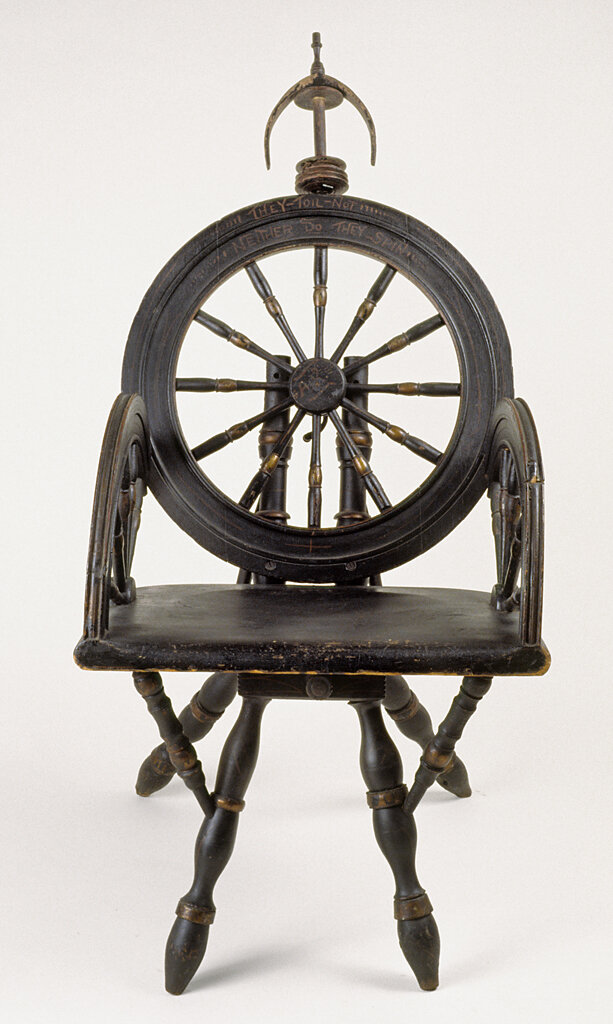By James Golden
Director of Interpretation
Every object has multiple meanings. Usually these need to be discerned or discovered—there’s the obvious meaning of what an object is and how it was used as well as the layers of secret meanings with which people endow the objects in their lives.
Unusually, this chair makes that process blatant.
Chairs are for sitting; spinning wheels for spinning fibers. Not anymore. Now spinning wheels are for sitting—and for an ideological respite at that.
Whoever made this object didn’t choose leftover spinning wheels at random. When this object was made c.1880-1910, they were the ultimate symbol of simplicity, the purity of hard work, and puritan values. In an era of dizzying industrialization, it was easy to laud the generation who’d fought the British Empire to win the American Revolution, coaxed food from the rocky soil, and clothed their children without using the Gattling gun, combine harvester, or Lowell mills. The fact that recent immigrants were now working these mills and farming this land made the Americanness of the spinning wheel generation all the more evident.
1876 witnessed both the Centenary of the Revolution and the end of Reconstruction. At a World’s Fair in Philadelphia, Americans celebrated unprecedented industrial and economic progress, cheering advances in agriculture, horticulture, machinery, art, and architecture. For the first time, a World’s Fair even included a groundbreaking women’s pavilion in this happy hundredth birthday.
Yet the election of that year produced an uncertain result in the Electoral College (ironically, it was the votes from the state of Florida at issue). Rutherford B. Hayes triumphed over Samuel Tilden after a backroom deal. He promised to remove the remaining federal troops from the South and no longer enforce the laws passed at the end of the Civil War that tried to construct an equal society. The South descended into the violence of Jim Crow, and most of the North looked the other way, weary of civil conflict.
Many Americans living in the 1870s and 1880s had lost relatives in the Civil War. Every New England green, it seems, grew a monument to the men who died for the constitution. Those who lived in the South had probably seen their towns and homes destroyed as well. Given the explosion of wealth that followed the War, it was easy to turn away from strife and celebrate togetherness and reunion, to celebrate an older ideal of America at a simpler time.
It was also easy to ask questions about the failure of values that lead to the war. Many Americans blamed their parents’ generation for not being tough enough to manage as citizens of a republic, for not having the virtue and puritan moral substance to endure the trials of keeping the union together before the War began. For both those looking to forget the war, and those looking to understand it, their grandparents’ generation–those who sat at spinning wheels and fought the Revolution–resonated all the more.
I wonder then, what this chair meant to its maker, to its owner, to anyone who sat in it. Was it a wistful remembrance of a simpler time? Was it a celebration of American virtue? Was it a call to shoulder the burdens of living in a republic? If a woman sat in it, did she think about how much work she was spared by the eclipse of the spinning wheel? Did she lament the loss of a truly difficult skill such as spinning to the dehumanization of the mills? We’ll never know. We can glimpse at some of the meanings, though, more clearly with this object than with others.

HD 86.118
Wood: oak, maple, pine; base metal, black and gold paint or gold leaf